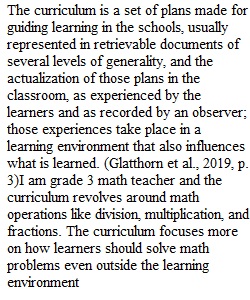


Q Purpose: Graduate students will collaboratively explore, examine, and critically evaluate foundation and current trends and issues in curriculum design and implementation. Clarifying, descriptive, and probing questions related to the required texts and resources provided will be in a reflective, “outline” that will be submitted as a PDF (see instructions below). Set-up: An email will be sent by the instructor approximately three weeks prior to the due date. This email will ask you to access a Google Sheet to sign up for specific dates/times to meet other students to complete this assignment. A Zoom online meeting space link will be shared with the group. Please note that all times listed on the shared Google Sheet are in Central Time Zone (CST). YOU MUST HAVE AT LEAST FOUR (4) INDIVIDUALS IN A GROUP – YOU MUST HAVE NO MORE THAN SIX (6) INDIVIDUALS IN A GROUP. If you prefer to create your groups in advance prior to the instructor’s email, the Google Sheet is located at this link: https://docs.google.com/spreadsheets/d/1tLQ-hXnFDbo_lcAEgjD9Zrn8-_YlwBhHfY_5GV2B1Yg/edit?usp=sharing PLEASE DO NOT CHANGE THE STRUCTURE OF THE SPREADSHEET. PLEASE DO NOT DELETE INFORMATION FROM OTHER STUDENTS. Instructions: During the collaborative group online meeting, answer the questions related to Modules 1 – 3. a. Before the online meeting, students are responsible for COMPLETING MODULES 1 – 3. b. Reponses should be in a different color than the questions (no answers in black font). c. If the question asks for a [COLLECTIVE RESPONSE], this means the answer should be a descriptive summary of ALL voices in the meeting. d. If the question asks for an [INDIVIDUAL RESPONSE], this means every individual in the group must provide a descriptive response to the question. Ensure that your name is connected to the individual responses (you may color code or use symbols). e. If specific quotes are highlighted or shared in a response, the quote needs to have a citation/reference in APA. f. Once the questions have been answered, every student should receive a copy of the responses, save the document as a PDF, and submit it individually (every student in the group) in Blackboard by the due date. Collaborative Reflection Outline #1: Questions 1. Record the names of the students attending the session. 2. [COLLECTIVE RESPONSE] – Share your definitions of curriculum from Module 1 with each other. Collectively, create a shared definition of curriculum based on your individual definitions from Module 1. Record the shared definition below.
Q 3. [INDIVIDUAL RESPONSE] – Share with your group the curriculum used in your classroom or school context and provide a brief summary of the description below. If you are not a teacher, share curriculum that either you are interested in exploring or have had experience as a student.4. [COLLECTIVE RESPONSE] – What is the purpose or importance of continually reviewing curriculum policies? 5. [INDIVIDUAL RESPONSE] – In Chapter 1, the authors suggest that being a member of a professional association may be helpful (p. 7). a) Share with the group any professional associations you are a member of and provide a brief description and a link to the association. If you are not a member of an association, share an association’s information that you might be interested in joining. b) Share how this association may help support you in curriculum efforts at you school site/context.
View Related Questions